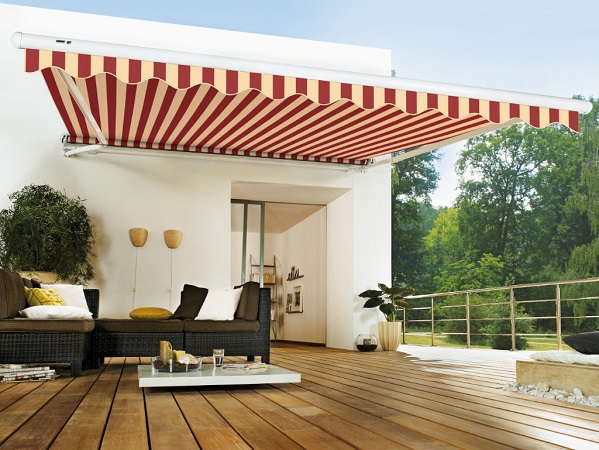Outdoor awnings provide shade on hot summer days, protect you and your home from rain and wind, and increase overall energy efficiency. From simple rigid awnings to retractable models, awnings come in a wide variety of shapes, sizes and materials. While traditional awnings were often made from wood, metal or cotton canvas, their modern cousins often feature more durable materials that require significantly less maintenance.



Acrylic
Acrylic and acrylic-coated synthetic fabrics are capable of holding up much longer than traditional canvas. They tend to reduce fading and repel water effectively. Homeowners can choose from 100 percent acrylic fabrics, polyester fabrics coated with acrylic and cotton-polyester blends with an acrylic coating. Uncoated polyester tends to be unsuitable for awnings because it is more susceptible to sun damage. Acrylic and polyester awning fabrics are usually opaque and relatively heavy. They work well in areas with high humidity and resist mildew and damage from ultraviolet light.
Vinyl
Awning fabrics can also be coated with vinyl. These materials tend to be slightly heavier than acrylic and acrylic-coated materials. They also have greater translucency, making them a good choice for backlit and illuminated awnings. According to Fabric Architecture Magazine, vinyl-laminated polyester is a good choice for areas with sustained high humidity. Vinyl-coated polyester, which has a thinner protective layer, also resists UV light and mildew but is less effective in humid environments. Vinyl-coated fabrics come in a relatively limited range of styles and colors compared to acrylic fabrics.
Metal
Steel and aluminum awnings were extremely common during the 1950s through the 1970s. They offer a slick, low-maintenance surface that could be painted to match the home. Steel awnings often require regular repainting to prevent rust, however, and aluminum is easy to dent. Metal awnings may also require more careful cleaning than fabric alternatives, especially if they have molded ridges or other areas that could collect dirt. This kind of awning cannot be rolled up, but some kinds come with hinges and can fold up or down.
Fiberglass
Fiberglass awnings are a lighter alternative to steel or aluminum. This kind of awning is molded with the color in the material, preventing the need to repaint but reducing your ability to change its look. Fiberglass awnings can be opaque or slightly translucent. Translucent models admit some light, reducing the risk of a “blackout” effect. Over time, fiberglass awnings can become brittle or crack and may need to be replaced.
Natural Materials
Historically, wood and natural fiber canvas awnings were used in many buildings. These materials offer the advantage of being relatively inexpensive but require more maintenance and more frequent replacement than modern materials. According to the U.S. Department of Energy, canvas awnings may need to be re-covered as often as every five to seven years. Wood and raw canvas also pose an increased risk of fire damage in areas where wildfires are a concern. California state law requires homeowners to use fireproof material such as treated cotton canvas for all awnings and other outdoor fabric structures.




